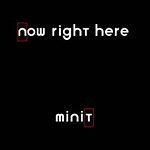
Minit Now Right Here
(Staubgold)
'...music is the idea itself, unaware of the world of phenomena, existing ideally outside the universe, apprehended not in space but in time only...' - (Samuel Beckett - Proust, 1931)
You may remember that one of the more forgettable manifestations of the pre-millennium decadence of the techno scene was the invention of 'Intelligent Dance Music' or 'IDM' - a genre that was meant to distinguish the whompa-whompa stuff of the likes of Orbital and Basement Jaxx from the supposedly more cerebral oeuvre of people like Boards of Canada and Aphex Twin. Silly, snobbish, and wrong, but marginally preferable to 'other' on an mp3 tag.
Minit is Jasmine Guffond and Torben Tilly from Sydney, Australia, formed in 1997, now living and working in Berlin, who (to quote their own PR) '...explore the psychedelic moment within trance-like listening states when all the sonic parts begin to slip in and out of cohesion...'
Right.
So here's a note to the future - specifically to those musicology dudes researching the history of Intelligent Trance Music twenty years from now: "The first recorded usage of 'ITM' to describe the genre which became the golden goose of p@RTI - the post-Armageddon Reformed Techno Industry label - in 2012 was the music critic Paul Rowlands describing the work of Minit (see index) in the legendary e-zine 'No Ripcord' in September 2004." (They always spell my name wrong.)
Droning is used pejoratively everywhere except in ITM - where it describes the art of priming the acoustic canvas with a more or less dynamic monotone that acts as a horizon-reference in the extended, tending-to-endless soundscapes that characterise the form.
Joking aside, it's hard to resist the banal observation that one person's 'trance-inducing' is another person's 'soporific', and that the music of Minit is not going to be everyone's cup of tea (verbena, mezcal, whatever). No toes will be tapped, nor catchy tunes hummed along to, in the course of surrendering to the Minit experience. Instead, provided engagement is successful, and allowing for a willing disengagement of the all-too-proximate scepticism that even the most disinterested listener might bring to this experience, you're more likely to find previously unheard sounds starting to sing their own plangent song inside your own head, as if in sympathetic resonance to this strangely compelling stimulus.
There are just four tracks on this CD on the Berlin Staubgold label - and none less than nine minutes in length. The first, eponymous track (pity you have to dig Jesus Jones and Fat Boy Slim out of your head first) - and the longest, at a few seconds short of twenty minutes - is a spectacularly well-controlled teasing out of the slightest of melodic interventions into an arching bell-curve of haunting sonorities, punctuated, once only, but dramatically, by the introduction of a chthonic bass-line that blooms with the secretive glory of a night-flowering orchid, and then begins to decay again into a twitchy, melancholy largo, concluding, finally, with a funereal, bell-like tolling into silence. I was reminded of Wagner, of all things - the Prelude to Act I of Parsifal - as I listened. But that's my problem. Let it take you where it will.
Now Right Here is the most recently recorded piece on the album: the other three tracks date from earlier. The intriguingly-titled Ijmuiden (why not Scheveningen, or Vlaardingen?), which concludes the album, for instance, was included on the 2002 Motion - Movement in Australian Sound compilation of Australian electronic and experimental music on the Preservation label, which includes familiar names like Oren Ambarchi (also now Berlin-based) and Clue to Kalo (Mark Mitchell).
Minit maintain an interesting-sounding visual arts practice in parallel with their musical work. One of their pieces I would very much like to have seen is the surround-sound installation entitled 'no sound, no movement, no memories' presented at the Scott Donovan Gallery in Sydney in January 2003 as part of the Sydney Festival celebration of the work of Samuel Beckett: an empty space, multiple arrays of speakers, variable timers, 24-minute repeater, and the only illumination a pair of flickering fluorescent lights. Even Sam, I daresay, would have approved.
20 January, 2005 - 00:00 — Paul Roylance